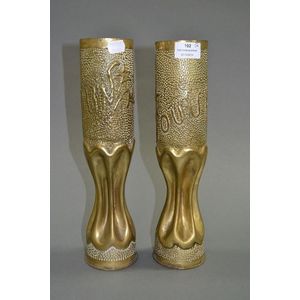Coade Stone Pedestals, English 1840
You must be a subscriber, and be logged in to view price and dealer details.
Subscribe Now to view actual auction price for this item
When you subscribe, you have the option of setting the currency in which to display prices to $Au, $US, $NZ or Stg.
- Provenance - A term used to describe the provable history of an antique or work of art, and thus an additional aid to verifying its authenticity. Provenance can have an inflating effect on the price of an item, particularly if the provenance relates to the early settlement of Australia, a famous person, or royalty. Less significant are previous sales of the item through an auction house or dealer.
- Coade Stone - Coade stone was the most famous of all the artificial stones popular at the end of the 18th century, because it had a very fine, hard finish, which resisted London 's acid rain and outlived natural stones. As well, it was cheaper than real stone, and could be used to make architectural embellishments, statuary and ornaments that retained their definition. It was made by the remarkable entrepreneur Eleanor Coade in a factory in Lambeth in the late 18th century. The factory closed in the early 19th century, but the manufacturing process has been revived in a new business bearing the same name in the late 20th century.
- Coade Stone - Coade stone is a type of artificial stone that was popular in the 18th and 19th centuries. It was invented by Eleanor Coade, who ran a factory in London that produced the stone. The stone was made by mixing together finely ground quartz, kaolin, and feldspar with a binder, such as lime. The mixture was then molded into shape and fired at a high temperature to produce a hard, durable material.
The stone was prized for its durability and resistance to weathering, making it ideal for use in architectural elements such as columns, cornices, and balustrades. It was also used to create decorative sculptures and garden ornaments. The stone was used in many prestigious buildings including the Royal Opera House, the Bank of England and Lambeth Palace.
Coade stone was also used to make a variety of decorative items such as vases, urns, and statues. It was highly prized for its ability to be shaped and sculpted into intricate designs, and was also known for its ability to imitate other types of stone.
The Coade stone factory closed in 1833, but the techniques and formulas used to make it were kept secret, so it was not possible to replicate it. - Pedestal - The columns that support many dining tables and most small occasional tables. They are usually turned, though octagonal-shaped pedestals were fashionable during the 1830s and 1840s.
This item has been included into following indexes:
Visually similar items

Pair of Chinese Yen Yen porcelain vases 39.5 cm high

An opposite pair of Chinese famille rose vases, late Qing Dynasty, 19th to early 20th century, delicately decorated in a soft palette with a lady seated at a scholar's desk and reading a book, a vase of a ferns and flowers upon a bamboo stand behind her; r

Pair of World War I brass trench art vases decorated with doves, also inscribed 'Esparges and Verdun'. 29 cm high

Pair of World War I Trench art vases, one embossed 'Verdun' (2)
